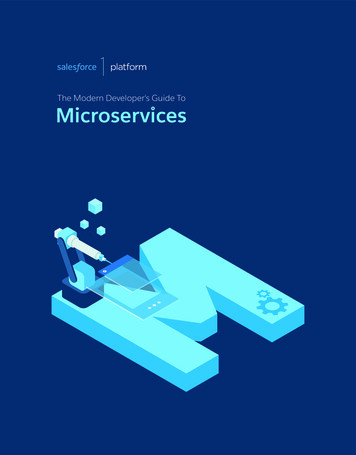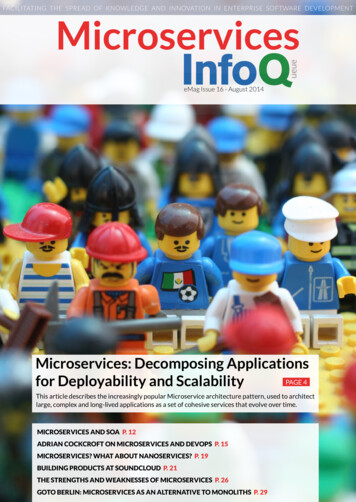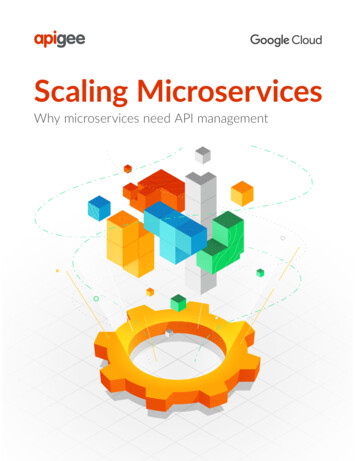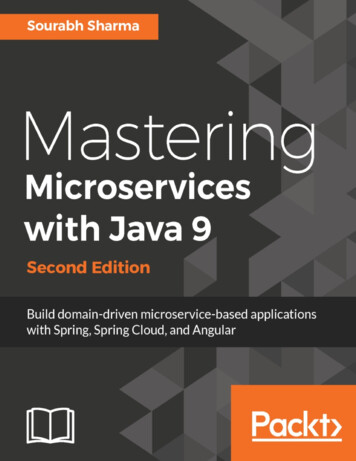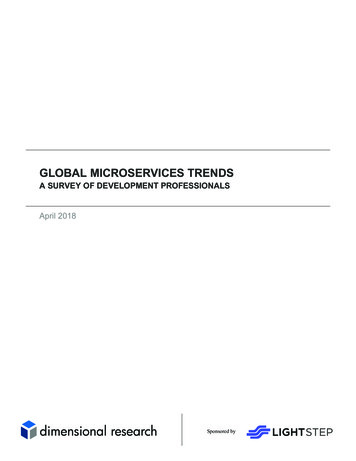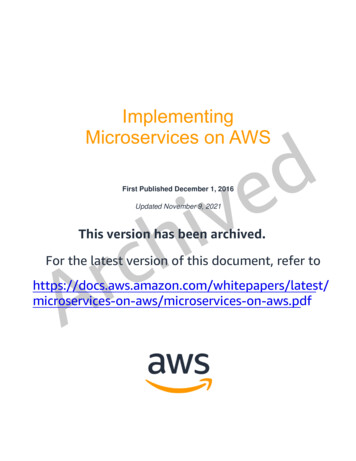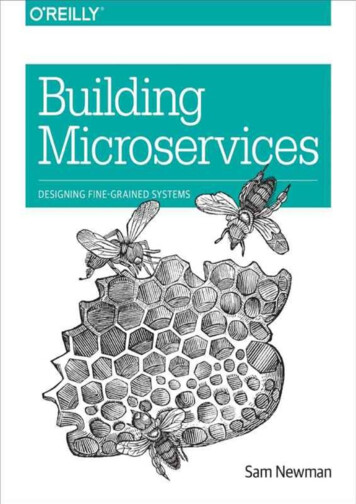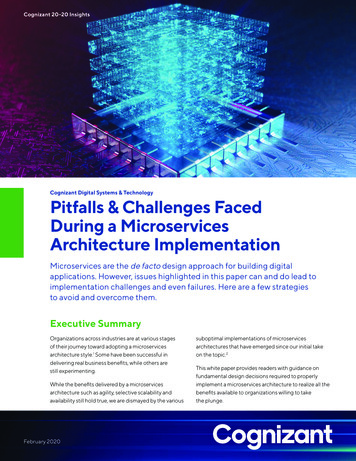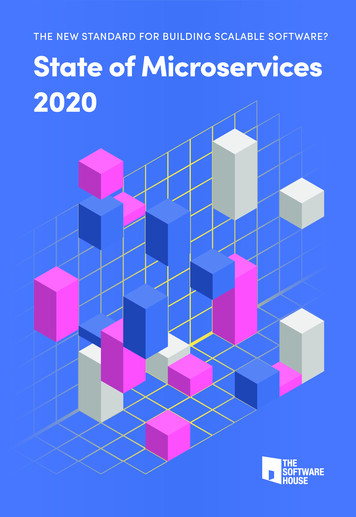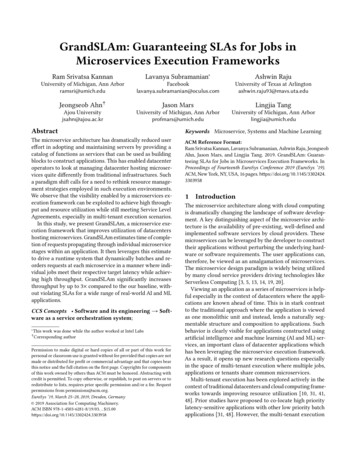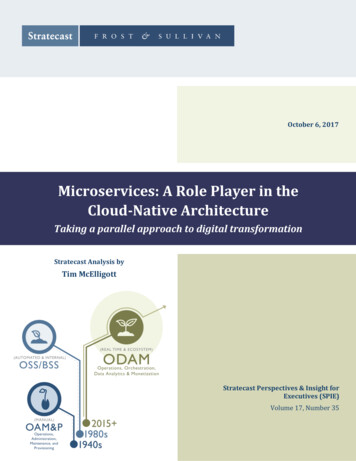
Transcription
October 6, 2017Microservices: A Role Player in theCloud-Native ArchitectureTaking a parallel approach to digital transformationStratecast Analysis byTim McElligottStratecast Perspectives & Insight forExecutives (SPIE)Volume 17, Number 35
Microservices: A Role Player in the Cloud-Native ArchitectureTaking a parallel approach to digital transformationIntroduction1Many technologies operate in parallel as a matter of redundancy. Others operate in parallel tofacilitate change management and cutover customers from an old version to a new version. It is nowoften said that the transformation from physical networks to virtual, software-controlled networkswill be achieved running the two networks and their systems in parallel—for up to 10 years. Thisdescription is only partially true, and not useful when executing atransformation.Virtual and physical networks supporting like-services may operate sideby-side, but they hardly work in parallel. They are not mirrored. They donot carry the same traffic. Instead, thousands of systems with hundredsof supporting processes operate at various levels of compatibility andcapability, while sending and receiving data to and from completelydifferent management and orchestration architectures.At any one time, networks and their support systems operate at different stages along the digitaltransformation continuum. Yet, these systems must remain interoperable and maintain acceptableperformance levels. Sure, physical and virtual networks appear to run in parallel, but the layers in theimage above also run in parallel—or do they? Tiny offsets in alignment are enough to make theseparallel tracks appear chaotic and unstable—two characteristics that networks cannot abide.While network architectures are top of mind in the current transformations of CommunicationsServices Providers (CSPs), operations and monetization software is undergoing its own architecturaltransformation—to a microservices architecture. Microservices will play an important role in hownew services are created and fulfilled. And recently, Amdocs revealed its strategy for a new kind ofparallel transformation that includes microservices. The company’s vision is to move its CSPcustomers through parallel journeys rather than parallel networks. The three journeys transforminfrastructure, applications, and people/processes on their way to becoming cloud native.Microservices are part of the applications journey; however, the technology relies upon and supportsthe other journeys. This interdependency is why each must move in parallel.This paper focuses primarily on Amdocs’ approach to building (or unbuilding, to be more specific)microservices, and where the architecture fits along the transformation continuum. The report willalso look at other changes CSPs must adopt for microservices to deliver on their potential, such asContinuous Integration/Continuous Delivery (CI/CD) and DevOps.2In preparing this report, Stratecast conducted interviews with: Amdocs – Dayana Nevo, Product Marketing Digital Experience Unit Amdocs – Yifat Kafkafi, Product Marketing, Technology & New OfferingsPlease note that the insights and opinions expressed in this assessment are those of Stratecast, and have been developedthrough the Stratecast research and analysis process. These expressed insights and opinions do not necessarily reflect theviews of the company executives interviewed.2 DevOps is a new approach to traditional application lifecycle management (ALM) process. DevOps creates a fast andstable work flow through development and IT operations. The TM Forum describes it for telecom operations as thetheory and practice of adopting continuous integration approaches.1SPIE #35, October 2017 Stratecast Frost & Sullivan, 2017Page 2
Microservices: the Key to Complex TransformationThe microservices architecture, as it pertains to telecom operations and monetization, is comprisedof small, composable blocks of functionality that are chained together as needed, and driven by thepolicies that are relevant to a given set of customers or a specific delivered service. Its function is toenable a single application to operate as a suite of small services that can bemanaged and deployed independently as part of multiple applications forspecific business purposes. In other words, microservices are disaggregatedapplication components built to deliver specific functions to otherapplications.Microservices by themselves have little impact. Theoretically, it is theiroperation within larger applications, functions, and architectures thatrenders them useful and effective. Microservices architectures have yet tobe fully vetted, because they have yet to be fully constructed for operations and monetizationsolutions pertaining to the communications industry.Microservices technology is under development and in the roadmaps of all major ODAM 3 suppliers.To date, the microservices concept has been tested in CSP networks around the world, following avariety of usage scenarios.4 CSPs expect that defining their business and operations needs throughmicroservices will: Make networks and systems more open and conducive to collaboration Lower the cost of operations Boost the ability of business management, monetization, and operations systems to scale Help automate service creation, testing, fulfillment, assurance, optimization and maintenance Enable customization and personalization Improve data-driven business and operational intelligence Instill programmabilitySo far, progress has been deliberate in both adoption by CSPs and development by softwareproviders. There are several legitimate barriers to moving quickly down the path of transformation: Disaggregation: Where to start and how far to go. Most leading suppliers havedisaggregated some of the solutions in their existing portfolios, mostly those solutionsserving monetization functions rather than operations and maintenance. But suppliersquestion just how granular they are willing to go in disaggregating existing, monolithic,bread-and-butter applications. The definition of “micro” appears to be subjective at thispoint in microservices development.Stratecast views Operations, Orchestration, Data Analytics & Monetization (ODAM) as the next step in the evolutionof business and operations support systems (BSS and OSS). For a graphical representation of this evolution, see thelower left corner of the report cover. For a description of ODAM, see the last page of this report.4 For more analysis on Microservices in ODAM, see Stratecast report OSSCS 18-05, Microservices: The CommunicationIndustry’s Next Little Big Thing – Why it is More Important to do Microservices Right than Fast, July 2017.3SPIE #35, October 2017 Stratecast Frost & Sullivan, 2017Page 3
Latency: A constant among engineering road blocks. One thing all the promising newapps on the horizon share is the need for low latency. However, as suppliers move their appsand microservices to the cloud, they continue to struggle with this niggling issue as largerapps “dip” into cloud-based microservices containers5 on a regular basis through APIs. APImanagement systems could potentially add to these expected increases in delay. Increased Complexity: It is not exponential, but it is troublesome. Microservices arenot inherently complex. In fact, in some cases their construct and functionality are simpler.However, operational support, including monitoring and service discovery, can becomemore complex. Business services also grow increasingly complex and difficult to supportwith precision. The open nature of microservices and use by many third-party applicationsalso drives complexity. Although there are open platforms, standards around APIs, andcommon cloud infrastructure management for these third-party relationships, microservicesbased components still require integration. DevOps and CI/CD: Bringing Microservices to market depends on these culturaland operational oddities. DevOps (Development and Operations) incorporates principlesfrom the methodology known as Agile SoftwareDevelopment. DevOps combines these principleswith the continuous delivery model that hasevolved for managing frequent software releases.In this model, CSPs and their development,operations, and quality assurance departmentscollaborate to deliver software in a continuousmanner that enables the business to more quicklyseize market opportunities. Unfortunately, DevOpsconcepts are foreign to most telecom operations departments, which require a significantshift in knowledge focus and operational practices. Continuous Integration/ContinuousDelivery is also a foreign concept—one telcos have trouble adjusting to even though thebenefits are clear. CI/CD is a long-awaited solution to long, expensive integration cycles, aswell as system-wide and error-prone upgrades, testing, and delivery models. Progress: Keeping in sync requires knowing one’s place along the transformationcontinuum. With so many components moving from legacy status to cloud-native, having aclear path ahead is important. Knowing the difference between cloud-enabled and cloudnative can help a CSP know when the time is right to adopt microservices. Infrastructure,applications, people, and processes all take their own journeys to the next generationnetwork. Each component of the CSP business will proceed at its own pace. For example,systems and processes cannot be automated while still operating in silos; nor canapplications become cloud native while running on and occupying individual virtualmachines. Different levels of modernization among the components restrict the full andcoordinated migration of networks. Microservices can be deployed today, but may not befully leveraged until all components–infrastructure, applications, people, and processes—arebrought to cloud-native status.Containers encapsulate microservices but have no operating system like virtual machines. Connectivity to containersand the microservices within are made through application programming interfaces (APIs). Leading container suppliersinclude Docker and Kontena.5SPIE #35, October 2017 Stratecast Frost & Sullivan, 2017Page 4
None of the barriers listed above are insurmountable. Some are not even engineering challenges.DevOps and CI/CD, for example, are primarily process and culture oriented; while the progressissue—keeping the transformation journeys in sync—is mainly a project management concern. Thisdoes not make them easier than engineering issues to solve, because they are all still complex;however, they are business problems that are not specific to telecom operations. Stratecast believesthat overcoming these challenges quickly will demonstrate CSPs’ ability to operate outside their ownboxes and in the broader Internet and cloud marketplaces.Maturity ModelsTo gauge CSP progress on the digital transformation pathway, the TM Forum launched its DigitalMaturity Model (DMM)6 in May 2017. The model calls for CSPs to transform traditional businessand operating models, cultures, and infrastructures. More importantly, it tries to help CSPs develop acoherent view of where they are on that path, or where to start, and then develop a strategy to getthere. The TM Forum is also developing a set of metrics to measure CSP digital transformationprogress. The DMM considers maturity across five key dimensions, as shown in the box below.Each dimension contains a set of sub-dimensions (currently 28 combined).The DMM helps all stakeholders across a CSP organization assess their own maturity in each ofthese dimensions. The model can beused as a planning tool to help CSPsidentify where improvement isneeded and what investment prioritiesshould be. The DMM can alsoaccount for differences in stakeholdervisions, strategies and businessimperatives, and help develop aroadmap that suits the entireorganization. The forum has eventurned the DMM tool into an appthat CSPs can now download.Although the TM Forum’s DMM isendorsed by more than a dozenindustry-leading CSPs, consultants,and suppliers, including Amdocs, the model is based on CSP self-assessment. This characteristic setsthe TMF’s DMM model apart from other models in the communications and networking industries.And, these industries are replete with maturity models from various industry forums and telecomsoftware suppliers. Amdocs has its own maturity model, which is explained in the next section ofthis report, along with Amdocs’ take on how microservices will play a significant transformationrole.6For more on the TM Forum Digital Maturity Model, click here.SPIE #35, October 2017 Stratecast Frost & Sullivan, 2017Page 5
Amdocs Microservices: One Step on the Transformation Journey, But Notthe First StepIn developing a CSP solution strategy, no supplier relies on a CSP’s self-assessment of where it is onthe transformation trail. Assessing needs is what consulting and professional services teams are allabout. The needs and capabilities of the CSP must be mutually agreed upon before a path totransformation can be set. And so, Amdocs starts with its CSP Cloud Maturity Model, whichdescribes, as mentioned in the introduction to this report, the three journeys of infrastructure,applications, and people/processes. Amdocs then defines the path from physical, siloed operationsto a virtual, fully-automated, cloud-native digital business.To create, apply and manage its maturity model, Amdocs leverages its Cloud Center of Excellence(CCoE), which was created to assist CSPs in building their cloud and microservices roadmaps. TheCCoE relies on collaborative teams across architecture, development, engineering, security andgovernance groups who gather and assess cloud capabilities and readiness. They also conduct testingand requirements gathering in relationship to business goals and objectives.Amdocs used this methodology internally to employ its own cloud environment before taking onthe solution consulting role with its CSP clients. The CCE helps determine factors such as: Where public or private cloud environments are the best fit for Amdocs’ CSP customers Where automation can be implemented most easily and reliably Security concerns associated with cloud-based solutions and services What processes need to change and how How to protect revenue streams and ensure billing and charging are not adversely affectedThe maturity model takes analysis from the CCE teams to determine, at any given time, where CSPsare in relationship to each of the three journeys, and what part of what journey needs to moveforward next. At first glance, the cloud maturity model may appear as a mere needsassessment analysis. However, the application goes much deeper in that it compares theneeds of each journey, prioritizes them, and determines, from a technology andcompatibility standpoint, which capability must come first to enable the next step.Stratecast believes this model aligns with the higher level of complexity in transforming tovirtual, software-driven, cloud-native autonomous networks.Models are one thing, implementation is another. Recently, Amdocs made a move to improve itsability to implement in new complex environments. Anticipating the specific skills required to helpCSPs transition to a microservices architecture and beyond, Amdocs quietly acquired a companycalled Kenzan in 2014. Kenzan specialized in ideation, architecture, development, DevOps andimplementation. The company’s specialty is in development testing, project management, andaccelerating software delivery.Kenzan recently worked with a global media company on building and implementing a new socialmedia platform to maintain and engage its audience. Kenzan built a new cloud platform for enablingapplications to be more scalable than in the CSP’s current physical data center. Using microservices,Kenzan built the architecture for a front-end portal, and implemented a platform for developmentteams to deploy applications continuously. Kenzan provided platform architecture, front-enddevelopment, platform development, and project management. More importantly, StratecastSPIE #35, October 2017 Stratecast Frost & Sullivan, 2017Page 6
believes the company delivered the kind of project management and development skillsAmdocs will need going forward as the company applies the three-journey process in itscloud maturity model. A high-level view of this model is outlined in Figure 1.Figure 1: Amdocs CSP Cloud Maturity Model (High-Level View)Source: AmdocsAs Figure 1 indicates, microservices come into play primarily after a CSP is cloud-enabled and is wellon the pathway toward becoming cloud-native. Apps are disaggregated into microservices tosupport their requirements for agility. Amdocs sees three main drivers of agility for CSPs: The speed of business The ability to quickly make changes and develop new capabilities with a fast code-toproduction cycle Total cost-of-ownership reduction and elasticityThe first applications that Amdocs disaggregated into microservices, based on these criteria, wereCustomer Relationship Management, Order Capture, and Catalog—three applications in desperateneed of increased agility across the industry. Other applications of equivalent need, but much morecomplex, are in the monetization realm.Taking its Own JourneyMirroring the journey Amdocs is taking with its customers, Amdocs began its move to cloud-nativeand microservices architectures with the CES 9 release of its software platform in 2013. CES 9focused on virtualization, as Amdocs became one of the first OSS/BSS suppliers certified onVMware. Amdocs also claims to have delivered the first virtualized real-time charging platform onSPIE #35, October 2017 Stratecast Frost & Sullivan, 2017Page 7
the VMware platform.7 Today, Amdocs continues to support hundreds of millions of subscriberswith virtualized workloads.In its next release, CES 10 in early 2016, Amdocs introduced a more cloud-enabled platform, whichincluded the use of more granular virtual machines, more automation, more modular solutions and afull embrace of open source software. Amdocs had already embarked on its cloud-native journeywith the launch of its Network Cloud Service Orchestrator (NCSO.) The NCSO is an open, catalogdriven solution for CSPs transitioning from physical networks to dynamic network-clouds. Theorchestrator continuously designs, fulfills, and assures network services from any virtual networkfunctions (VNF) supplier.Amdocs’ cloud-native journey continued with its microservices-based Digital Enablement Platformand catalog.In 2013, the road leading through the lands of virtualization and software-defined networking wasunclear. Microservices got barely a mention. Still, suppliers knew they would finish in the cloud, andbegan working on that assumption. All development work, until recently, served as a preamble, asmore certain strategies began to coalesce in 2017.Ready for MicroservicesWith the right platforms in place, Amdocs readied its microservices portfolio by setting some designprinciples. The company specified that microservices should: Be modular, reusable and organized around specific business/technical capabilities Standardize on technologies that accelerate adoption, improve quality and fosterreusability Not include superfluous capabilities or unnecessary memory in order to retainsimplicity Stay independent by being manageable and serviceable without impacting othermicroservices or affecting their performance Deploy, provision, operate, scale in, and scale out automaticallyAmdocs’ Digital Enablement Platform is the deliverycontextual and personalized engagements. Theplatform is open, modular, cloud-native, andmicroservices based. The platform also supportsservice & partner enablement, omni-channelengagement, and digital versions of catalog, care, andcommerce.vehicle for its omni-channel experience, andStratecast believes Amdocs has the mostwell-articulated microservices stories so farwithin the CSP operational domain. Oneexample of this decomposition is Amdocs’Commerce & Care business domain, whichis decomposed into nine granular, valuebased business capabilities.A key capability for the digital experience platform isproviding care and commerce on every channel. Thisis where the decomposition into microservicesbegins. Stratecast believes Amdocs has the most well-articulated microservices stories so far withinthe CSP operational domain. One example of this decomposition is Amdocs’ Commerce & Care7For more on Amdocs’ virtualized Real-Time Charging solution, click here.SPIE #35, October 2017 Stratecast Frost & Sullivan, 2017Page 8
business domain, which is decomposed into nine granular, value-based business capabilities for agile,scalable, always-on and standardized processes called domains. These domains are: product,customer, ordering, sales, billing, engaged party, resource, service, and common domains. Domainsare further segmented into sub-domains, and microservices. Connectivity to and from microservicesis accomplished through open APIs, as shown in Figure 2.Figure 2: Domains & Microservices: A Portion of the Care & Commerce Domain MapSource: AmdocsIn the Product domain above, for example, the Offer sub-domain includes three microservices (sofar): Offering Discovery, Category, and Product Offering. The decomposition process is fluid, asdomains and sub-domains continue to be sub-divided. Each microservice can stand alone and beused with existing BSS, and for multiple service offerings. Amdocs’ Digital Enablement Platformties the microservices layer and the integration and digital experience layers together to make themavailable to any BSS or channel application through open APIs. Stratecast believes this level ofintegration and open APIs will help CSPs overcome their biggest obstacle to becoming themost essential component in the platform-based digital economy: being easy to do businesswith.Microservices in ActionAmdocs has employed microservices in live service delivery. One example comes from a NorthAmerican CSP—a mobile operator providing mobile device activation for a customer purchasing aSIM card. The solution relies on the domain-driven microservices design described above, andleverages nine microservices, including: Shopping Cart, Catalog Management, and DeviceIdentification. The solution also leverages tools from open-source developers to create a fullyautomated CI/CD pipeline, as well as the Amdocs Microservices360 framework for managing andorchestrating microservices. For CSPs using this approach, the expected benefits include:Fewer call center inquiries An improved customer experience from a faster, automated process Increased agility and responsiveness Cloud-native capabilitiesFigure 3, below, shows both the CI/CD pipeline and the open source tools used in scenarios suchas the CSP example above, as well as from other service delivery requests. It also references Jenkins,which is used as a CI/CD orchestrator and manager.SPIE #35, October 2017 Stratecast Frost & Sullivan, 2017Page 9
Figure 3: The CI/CD Pipeline Using Open Source ToolsSource: Amdocs/StratecastGiven Amdocs’ microservices architecture and deployment, its cloud maturity model, and fullembrace of open source software and new best practices such as DevOps and CI/CD, the companyhas shown a navigable path to the future. The ideal of a cloud-native, virtual architecture supportingdigital services with automation and agility appears attainable. The path is not yet paved, and likelynever will be as unforeseen challenges are part of every complex transformation. And the number ofpaths that will ultimately be cleared will depend in part on aggressive strategies such as the oneAmdocs has initiated.SPIE #35, October 2017 Stratecast Frost & Sullivan, 2017Page 10
StratecastThe Last WordThe microservices architecture presents an unnerving scenario for suppliers of operations andmonetization software—similar to the one that network equipment manufacturers faced when theprospect of virtualization became a business reality for them. Software suppliers are now asked todisaggregate the systems that are the backbone of their business. The greatest concern in thisendeavor, should they choose to accept it, is how to do so without sacrificing differentiation andadversely affecting their revenue.Becoming integral to the processes and practices of CI/CD and DevOps can go a long way towardprotecting the value of each microservice, sub-domain, domain, and the overall business domain.These practices are making suppliers such as Amdocs more valuable than ever before. The agilitythat microservices instill is too precious for CSPs not to push their suppliers to adopt this approach;so, it is best for suppliers to find the silver lining and go with this transition.Stratecast believes Amdocs has one of the more fully-fleshed microservices strategies among itspeers. Amdocs also appears to have fully embraced the open source community. For CSPoperations departments, Amdocs has helped place microservices in its proper place within thetransition to next-generation networks. There is much work still to be done in all three layers of thejourney that the microservices architecture depends on in order to achieve its promise. Becomingcloud native is the most important example, so far—one step below the fully autonomous network.With the complexity of digital, virtual, and cloud transformation, it is important to know in whatorder to adopt new technologies. Amdocs’ maturity model paints a good picture of this process.Despite the attention that microservices have received over the last two years in the telecomindustry, the technology is still in its early stages. This gives CSPs a little time to begin the hard workof cultural change in the meantime.Tim McElligottSenior Consulting Analyst – Operations, Orchestration, Data Analytics and Monetization (ODAM)Stratecast Frost & Sullivantmcelligott@stratecast.comSPIE #35, October 2017 Stratecast Frost & Sullivan, 2017Page 11
About ODAMThe processes and tools that communications service providers (CSPs) have utilized to run their businesseshave changed over time. More than a half-century ago, CSP network and business management processeswere manual (OAM&P). As CSPs evolved over the years, so did the operations support systems (OSS) andbusiness support systems (BSS) that address CSP business and network management needs. In recent years,the lines between OSS and BSS have become less clear, with much overlap. In addition, the roles in whichOSS and BSS operate have expanded beyond traditional boundaries. As such, Stratecast now uses the termOperations, Orchestration, Data Analytics & Monetization (ODAM) to encompass both the traditional OSSand BSS functions and the new areas in which business and operations management must now work together,including virtualized networks and telecom data analysis.About StratecastStratecast collaborates with our clients to reach smart business decisions in the rapidly evolving and hypercompetitive Information and Communications Technology markets. Leveraging a mix of action-orientedsubscription research and customized consulting engagements, Stratecast delivers knowledge and perspectivethat is only attainable through years of real-world experience in an industry where customers are collaborators;today’s partners are tomorrow’s competitors; and agility and innovation are essential elements for success.Contact your Stratecast Account Executive to engage our experience to assist you in attaining your growthobjectives.About Frost & SullivanFrost & Sullivan, the Growth Partnership Company, works in collaboration with clients to leverage visionaryinnovation that addresses the global challenges and related growth opportunities that will make or breaktoday’s market participants. For more than 50 years, we have been developing growth strategies for the Global1000, emerging businesses, the public sector and the investment community. Is your organization preparedfor the next profound wave of industry convergence, disruptive technologies, increasing competitive intensity,Mega Trends, breakthrough best practices, changing customer dynamics and emerging economies? For moreinformation about Frost & Sullivan’s Growth Partnership Services, visit http://www.frost.com.CONTACT USSPIE#35,October2017 Stratecastdial Frost& Sullivan, 2017Page 12Formoreinformation,visit www.stratecast.com,877-463-7678,or email inquiries@stratecast.com.
Microservices technology is under development and in the roadmaps of all major ODAM3 suppliers. To date, the microservices concept has been tested in CSP networks around the world, following a variety of usage scenarios.4 CSPs expect that defining their business and operations needs through microservices will:
